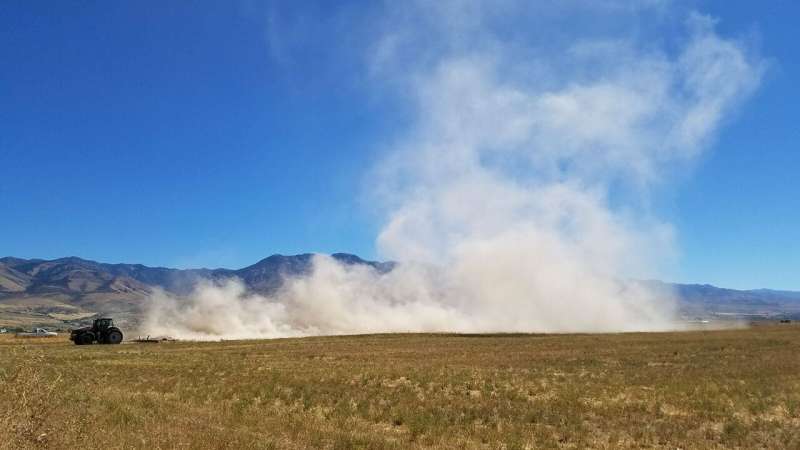This article has been reviewed according to Science X's editorial process and policies. Editors have highlighted the following attributes while ensuring the content's credibility:
fact-checked
peer-reviewed publication
trusted source
proofread
Researchers find that dust in the atmosphere is feeding algae in mountain lakes

The world's freshwater systems are in a sort of a climate-change cocktail—rising temperatures, fluctuating levels of environmental acidity and shifting concentrations of dissolved nutrients that settle into the lakes, ponds and wetlands of the world are tweaking the recipe of these complex and delicate freshwater systems, causing fundamental shifts in the way they function.
This is something to pay close attention, said Janice Brahney, who leads a team of researchers from USU working on a series of pioneering publications on the topic, the results of an intensive 15-year effort.
Researchers are trying to understand what is driving recent and troubling changes to mountain headwaters across the globe, which support roughly half the world's population with freshwater for drinking, irrigation, hydropower, industry and use in homes. The latest from the team is a publication in Global Change Biology showing how algae growth is connected to atmospheric dust, with lead author Juan Manuel González-Olalla and James Powell.
Microscopic algae called phytoplankton are the foundation of the food chain for these aquatic systems, and the integrity of the whole ecological structure relies on the trajectory of these microscopic plants. When shifts occur in their chemical makeup because of climate-change stressors like warming or changes in acidity, the entire balance of life poised precariously around phytoplankton shifts too.
The new research shows that dust deposition from the atmosphere acts as a fertilizer for algae, broadening its growth tolerance against other stressors, said Brahney, who is from the Department of Watershed Sciences in the Quinney College of Natural Resources.
Dust has always been a factor for freshwater systems, but modern dust, derived from industrial, urban, combustion and agricultural sources, contains more phosphorus, as well as alien materials like plastics and pesticides. Sediment deposited by wind and storms into lakes and ponds now adds phosphorus to the system, increasing the algae's tolerance for shifts in temperature and acidity, according to the research.
More growth under climate-change stress sounds like a good thing, but too much growth can be a major issue in these kinds of nuanced systems. Rising levels of nutrients in freshwater systems has potential to assist all kinds of organisms in expanding growth, including things like cyanobacteria, which produce toxins, Brahney said.
"Only recently have we started to see troubling outbreaks of toxic algal blooms in mountain environments. So these changes are happening fast and are really concerning. It's important we get to the bottom of this," Brahney said. "Toxic blooms in mountain lakes like the ones we've seen recently in remote mountain lakes are unprecedented."
Pinpointing the precise factors for these complex shifts has been tough for researchers—the causes and timing of ecosystem shifts are often obscured when multiple disturbances coincide, such as in this case. It has already been well-documented that levels of atmospheric dust around the world are increasing, and that when the airborne particles from more-frequent dust storms eventually settle, some of it makes its way into water ecosystems. But what happens next has been hard to decipher.
Until recently, experiments examining the effects of dust on phytoplankton have been based just on correlation, Brahney said. The problem with pinpointing changes more precisely has been the difficulty in sourcing enough dust—the amount of dust researchers can collect from the atmosphere is miniscule, even though the cumulative effect can be large on environmental systems.
To rectify this, Brahney launched the first-ever dust monitoring program across the Western U.S. with a specific goal to capture enough dust to run these types of experiments. The project has now grown to include 30 sites sampled monthly.
The latest research also identifies high-risk areas across the globe where dust-induced changes are expected to have the greatest impacts, including the Western United States.
"Dust is underappreciated as an ecosystem driver, but will inevitably become a problematic part of our future," she said. "It connects disparate ecosystems, crosses political and geographic boundaries, and requires policy and treaties to manage. It's something that we urgently need to better understand."
More information: Juan Manuel González‐Olalla et al, Dust storms increase the tolerance of phytoplankton to thermal and pH changes, Global Change Biology (2023). DOI: 10.1111/gcb.17055
Journal information: Global Change Biology
Provided by Utah State University





















